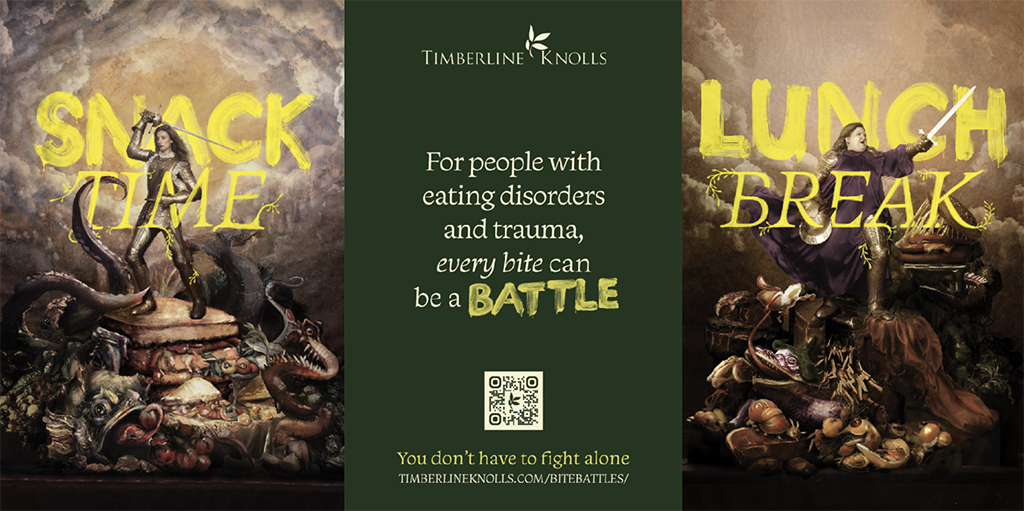The 15-foot by 20-foot portraits loom large.
The dramatic subjects call to mind the glorious Joan of Arc preparing to charge into battle or a victorious medieval warrior defeating a dragon.
However, the first indication that these pieces of art are something different emerges when you start to notice the finer details.
Like the fact that one valiant knight appears to be standing atop a sandwich while gummy bears and french fries are incorporated into the other epic works in the series.

These are not, as it turns out, Renaissance masterpieces but rather the work of acclaimed photographer Szilveszter Makó, who is best known for shooting covers for Vogue and Vanity Fair.
While the three women who are portrayed in these enormous works of art are considered brave warriors, their triumphs are more personal in nature. Instead of conquering an opposing army or slaying a mythical creature, they have topped eating disorders and co-occurring conditions.
The three women — Shannon Hostetter, Threasa Kluever and Heather Seiler — are all alumni of Timberline Knolls, a residential treatment facility in Illinois focused on addressing eating disorders, the effects of trauma, mental illness and addiction.
Additionally, they are now also the faces of the center’s Every Bite a Battle campaign.
Where the battle began
Mark Palmenter is the chief marketing officer of Acadia Healthcare, which acquired Timberline Knolls in 2012.
He explains to MM+M that the campaign began with a company-wide refresh and a new purpose is to lead care with light. He says the brand sought to draw on the elements of renewal, hope and rebirth for the campaign, building it around taking a different approach to addressing eating disorders.
“There’s a tendency [in campaigns about eating disorders] to make sure that the clinical perspective is strong,” he says. “But what we wanted to do was incorporate personal emotion. We were looking to develop a campaign that had all the aspects that we see in the women who are in our Timberline Knolls treatment programs, these elements of heroism, victory, heart and the remarkable journey that they go through.”
Educating the marketing
The Austin-based advertising agency Bakery helped lead Acadia to its goal, but before any of that occurred, creative director Rodrigo Rothschild underwent some education first.
“I can definitely say that my perspective on eating disorders has a ‘before’ and an ‘after,’ marked by working on this campaign,” he tells MM+M.
The agency’s research led him to want to create messaging that focused less on the particulars of eating disorders and instead centered on the strength and resilience of the people who successfully address them.
“These are people who found ways to overcome their eating disorders and fight them every day,” he says. “We realized that there was no communication out there, no campaign out there, addressing the problem that way.”

While Rothschild doesn’t remember the exact moment when the idea of building the campaign around these enormous Renaissance-style portraits emerged, he points to some of the inspirations behind them.
“In our word bubble, there was always ‘battle,’” he recalls. “There was always ‘heroic’ and there was always this idea of making portraits of the alumni who were going to be the faces of the campaign.”
Acadia and Bakery chose the women who would be the subjects of the portraits through a Zoom casting call of Timberline Knolls alumni. The three women who were selected were flown to Milan for a photoshoot – one which used elaborate sets created especially for the campaign.
While the decision to shoot in Milan was driven by logistics and schedules, Rothschild feels it was also fitting given the city’s connections both to Renaissance art and its status as a fashion capital.
As far as Makó’s involvement, Rothschild says it began with a suggestion from a friend of Bakery founder Micky Ogando, who had come across the photographer’s work in the past.
“[Makó] was kind of itching to get a little bit out of his comfort zone and while this was aesthetically close to what he does, thematically it was something he had never done before and that intrigued him,” Rothschild recalls.
Real voices for a real campaign
Using Timberline Knolls alumni was a key part of the campaign’s authenticity, Palmenter adds, acknowledging that these are real women who have gone through the organization’s programs.
One of them was a patient at Timberline Knolls and is now a full-time employee there since she noted that the journey was so impactful to her.
“We wanted the personal, authentic stories — as well as the clinical components — to come through more strongly than in our campaigns in the past,” Palmenter says.
Among the positive responses received by the campaign, perhaps the most meaningful feedback to Palmenter has come from Timberline Knolls alumni.
“When we shared the videos of these three women, the heroines who told their own stories, there was not a dry eye on the call of around 40 alumni,” he says. “They felt that this was so representative of their individual stories. One of them said, ‘This is kind of the final step in my own journey to recovery.’”
While the portraits – which are now on display at Timberline Knolls – are the visually stunning centerpieces of the campaign, Palmenter places equal emphasis on the stories of the three women’s journeys, as recounted on the campaign microsite.
“[Every Bite a Battle] has helped us drive a better understanding of the complexity of eating disorders and the accompanying co-occurring conditions,” he concludes. “We all have this warrior inside of us ready to go to battle and together we can support one another, lift each other up and celebrate these daily victories.”







